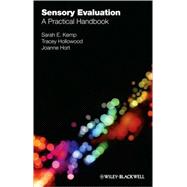
What is included with this book?
Dr Tracey Hollowood is Associate Director: Sensory and Consumer Research, Sensory Dimensions Ltd, Bulwell, Nottinghamshire, UK.
Dr Joanne Hort is Associate Professor in Sensory Science, Nottingham University, UK.
| Introduction | |
| Planning Your Sensory Project | |
| The human senses | |
| Sight, smell, taste, touch and hearing | |
| Factors influencing sensory measurements | |
| Psychological and physiological errors | |
| Factors influencing test design | |
| Defining your clients needs: identifying test objectives, application, budget, deadlines, setting action standards | |
| Hypothesis testing | |
| Experimental design: balancing, randomisation, blocking, Latin square, replication, size of sample/panel | |
| Statistical analysis | |
| Professional conduct, ethical issues and good laboratory practice | |
| Hygiene | |
| Safety | |
| Ethical handling of panellists (informed consent, ethical committee approval, employment law, panellist records, Data Protection Act) | |
| Health consideration for panellists: Allergens, medications | |
| IP consideration.. | |
| Requirements for Sensory Testing | |
| Testing Facilities | |
| Equipment, lighting, colour, temperature, humidity | |
| Purpose built facilities: sensory testing laboratory, consumer test facilities, specific applications | |
| Temporary facilities: portable booths, CLT | |
| Testing in the home | |
| Samples | |
| Preparation and presentation: palate cleansers, serving vessels, carriers, coding, order of presentation | |
| Reference and control samples | |
| Sample assessment procedures | |
| Disclosing ingredients | |
| Panellists | |
| Screening and Selection | |
| Training | |
| Motivation | |
| Monitoring performance | |
| Working with panels: setting up new panels, integrating new individuals into existing panels | |
| Good working practices for panellists: Smoking, personal hygiene, perfume | |
| Data Capture | |
| Pen and paper | |
| Computerised systems | |
| Video cameras | |
| Portable systems | |
| Sensory Test Methods | |
| Each test is described using the same format including - objective and rationale, experimental design, procedure, example of worksheet, data analysis, conclusion, a worked example and 'dos and don'ts'.Discrimination tests | |
| Introduction | |
| Overall difference Tests: Triangle, Duo-Trio, Difference from control, Similarity | |
| Attribute specific: Paired comparison (2 AFC), 3AFC, Ranking | |
| Other tests: same/difference (with surety rating = R-index), Threshold tests | |
| Descriptive tests | |
| Introduction | |
| General procedure: qualitative attribute generation, quantitative analysis (inc scale options) etc | |
| Specific methodology: QDA, Spectrum, QFP, Free Choice Profiling, Consensus | |
| Time Intensity | |
| Affective/Consumer tests | |
| Introduction | |
| Qualitative methods: focus groups | |
| Quantitative methods: preference, hedonic rating | |
| Questionnaire design | |
| Combining results from different tests | |
| Linking sensory and consumer data | |
| Completing the Project | |
| Reporting | |
| Report format: title, abstract or summary, aims/objectives, action standard, introduction/background, method, results and discussion, insight, conclusions, recommended action, references | |
| Data storage | |
| Documentation | |
| Glossary .#60 | |
| Table of Contents provided by Publisher. All Rights Reserved. |
The New copy of this book will include any supplemental materials advertised. Please check the title of the book to determine if it should include any access cards, study guides, lab manuals, CDs, etc.
The Used, Rental and eBook copies of this book are not guaranteed to include any supplemental materials. Typically, only the book itself is included. This is true even if the title states it includes any access cards, study guides, lab manuals, CDs, etc.